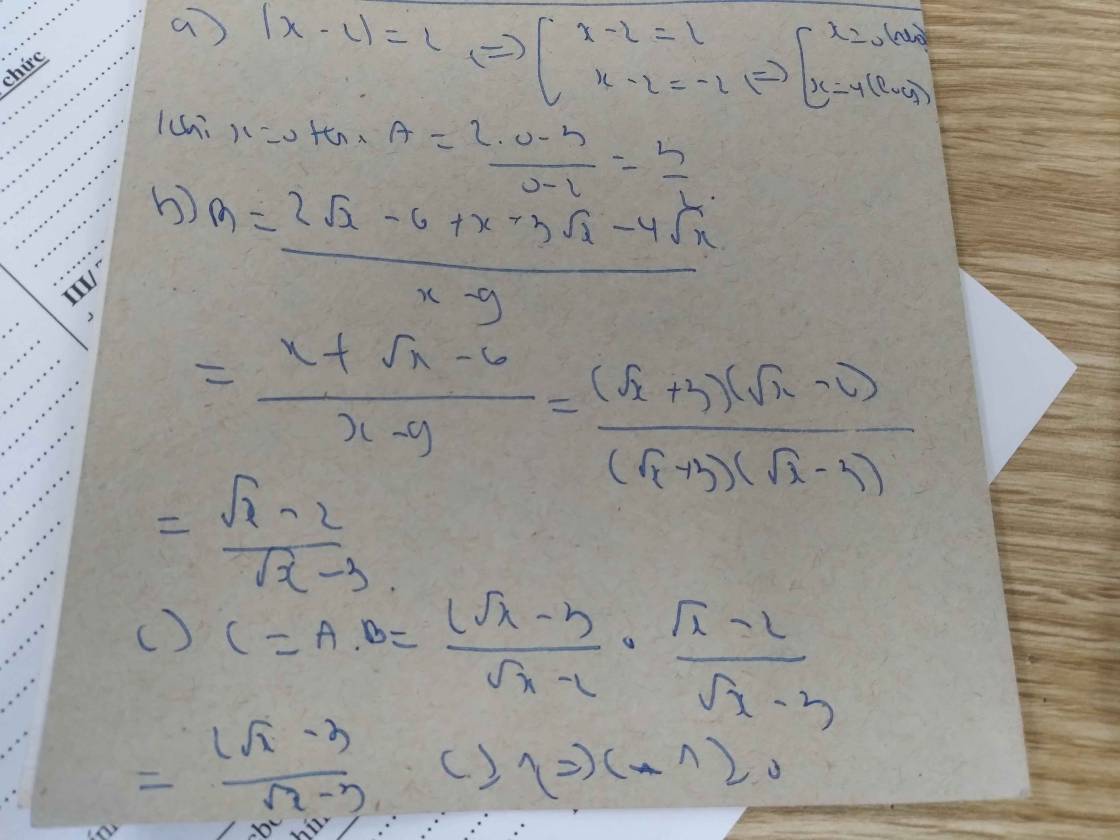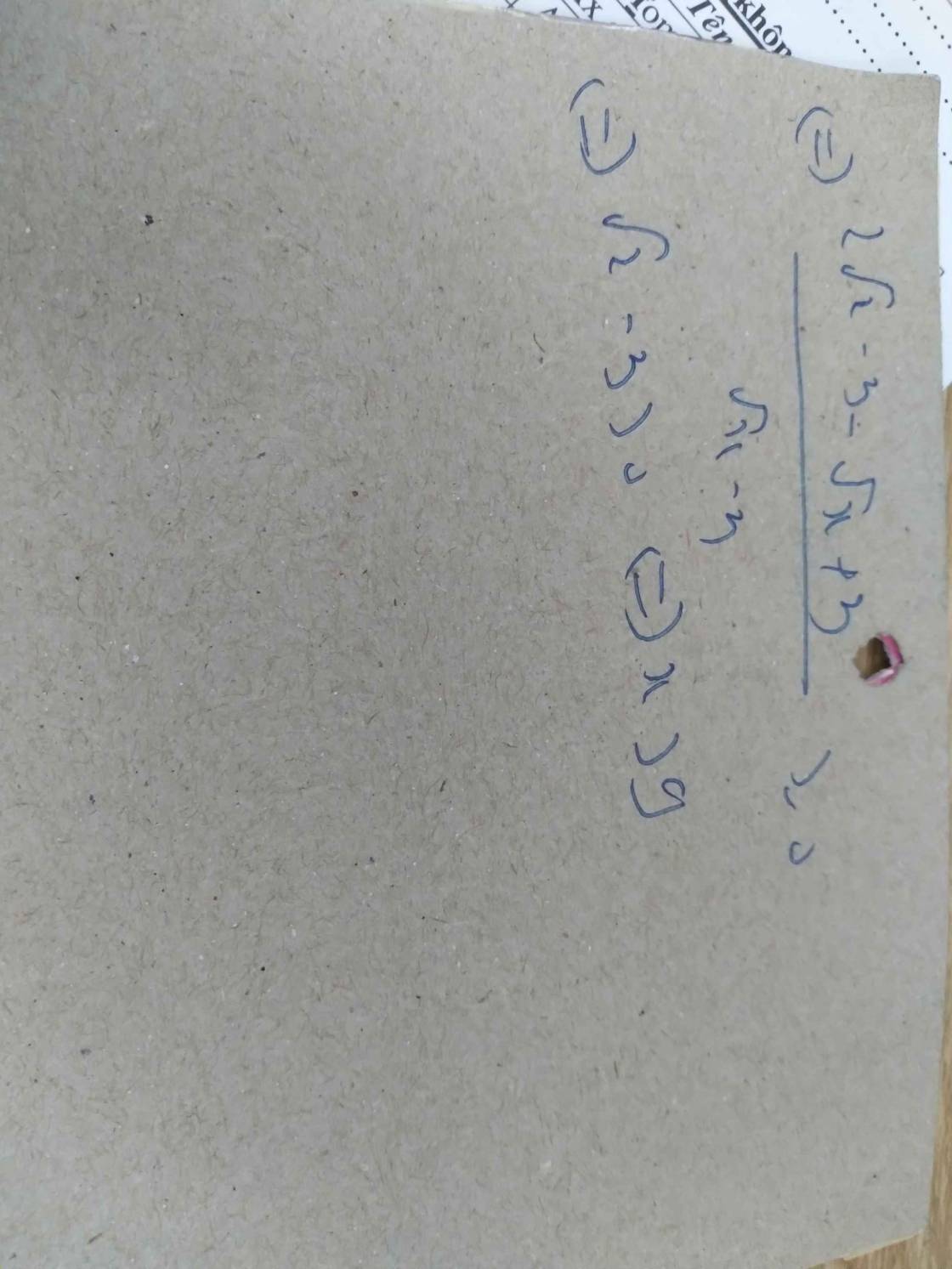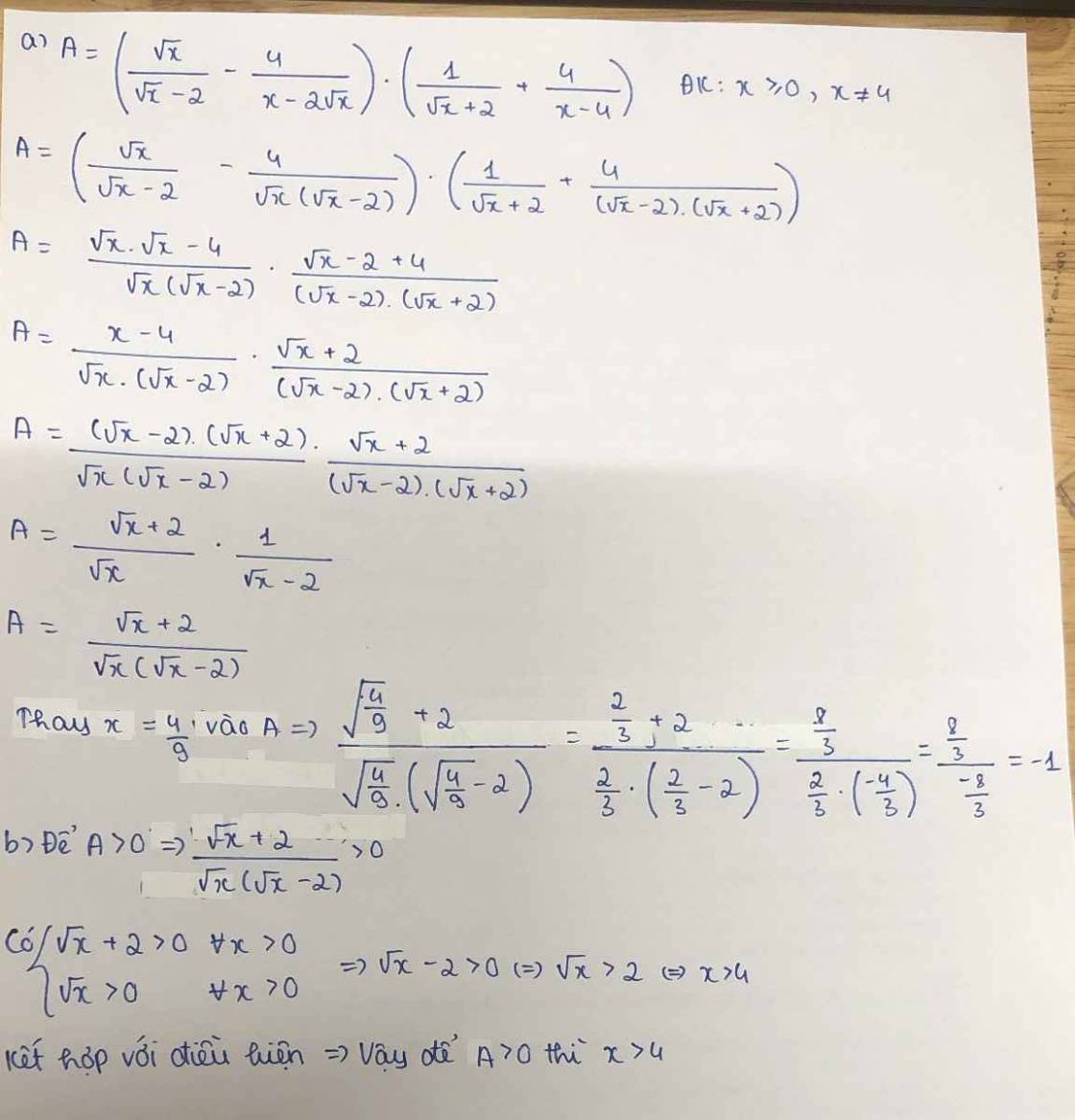Cho biểu thức A = x 2 - 5 x + 4 x 2 - 10 x + 9 . Tìm x để A = 0
Hãy nhập câu hỏi của bạn vào đây, nếu là tài khoản VIP, bạn sẽ được ưu tiên trả lời.


Bạn nên gõ đề bằng công thức toán (biểu tượng $\sum$ góc trái khung soạn thảo) để mọi người hiểu đề và hỗ trợ bạn tốt hơn nhé.

\(\frac{x+2}{x+3}-\frac{5}{x^2+x-6}+\frac{1}{2-x}=\frac{x+2}{x+2}+\frac{-5}{x^2+x-6}+\frac{-1}{x-2}\)
=\(\frac{\left(x+2\right)\left(x-2\right)}{x^2+x-6}+\frac{-5}{x^2+x-6}+\frac{-1\left(x+3\right)}{x^2+x-6}=\frac{\left(x+2\right)\left(x-2\right)-5-1\left(x+3\right)}{x^2+x-6}\)
=\(\frac{x^2-4-5-x-3}{x^2+x-6}=\frac{x^2-x-12}{x^2+x+6}\)
\(\frac{x^2-x-12}{x^2+x-6}=\frac{x^2-x-12}{\left(x-2\right)\left(x+3\right)}\)
Để giá trị của PT A được xác định thì \(\left(x-2\right)\ne0\)và \(\left(x+3\right)\ne0\)
=> \(x\ne2\) và \(x\ne-3\) thì PT được xác định

1) a) Căn thức có nghĩa \(\Leftrightarrow4-2x\ge0\Leftrightarrow2x\le4\Leftrightarrow x\le2\)
b) Thay x = 2 vào biểu thức A, ta được: \(A=\sqrt{4-2.2}=\sqrt{0}=0\)
Thay x = 0 vào biểu thức A, ta được: \(A=\sqrt{4-2.0}=\sqrt{4}=2\)
Thay x = 1 vào biểu thức A, ta được: \(A=\sqrt{4-2.1}=\sqrt{2}\)
Thay x = -6 vào biểu thức A, ta được: \(A=\sqrt{4-2.\left(-6\right)}=\sqrt{16}=4\)
Thay x = -10 vào biểu thức A, ta được: \(A=\sqrt{4-2.\left(-10\right)}=\sqrt{24}=2\sqrt{6}\)
c) \(A=0\Leftrightarrow\sqrt{4-2x}=0\Leftrightarrow4-2x=0\Leftrightarrow x=2\)
\(A=5\Leftrightarrow\sqrt{4-2x}=5\Leftrightarrow4-2x=25\Leftrightarrow x=\frac{-21}{2}\)
\(A=10\Leftrightarrow\sqrt{4-2x}=10\Leftrightarrow4-2x=100\Leftrightarrow x=-48\)

`a)|x-2|=2<=>[(x=4(ko t//m)),(x=0(t//m)):}`
Thay `x=0` vào `A` có: `A=[2\sqrt{0}-3]/[\sqrt{0}-2]=3/2`
`b)` Với `x >= 0,x ne 4` có:
`B=[2(\sqrt{x}-3)+\sqrt{x}(\sqrt{x}+3)-4\sqrt{x}]/[(\sqrt{x}+3)(\sqrt{x}-3)]`
`B=[2\sqrt{x}-6+x+3\sqrt{x}-4\sqrt{x}]/[(\sqrt{x}+3)(\sqrt{x}-3)]`
`B=[x+\sqrt{x}-6]/[(\sqrt{x}+3)(\sqrt{x}-3)]`
`B=[(\sqrt{x}+3)(\sqrt{x}-2)]/[(\sqrt{x}+3)(\sqrt{x}-3)]`
`B=[\sqrt{x}-2]/[\sqrt{x}-3]`
`c)` Với `x >= 0,x ne 4` có:
`C=A.B=[2\sqrt{x}-3]/[\sqrt{x}-2].[\sqrt{x}-2]/[\sqrt{x}-3]=[2\sqrt{x}-3]/[\sqrt{x}-3]`
Có: `C >= 1`
`<=>[2\sqrt{x}-3]/[\sqrt{x}-3] >= 1`
`<=>[2\sqrt{x}-3-\sqrt{x}+3]/[\sqrt{x}-3] >= 0`
`<=>[\sqrt{x}]/[\sqrt{x}-3] >= 0`
Vì `x >= 0=>\sqrt{x} >= 0`
`=>\sqrt{x}-3 > 0`
`<=>x > 9` (t/m đk)

Bài 5:
a: Thay \(x=4+2\sqrt{3}\) vào E, ta được:
\(E=\dfrac{\sqrt{3}+1-1}{\sqrt{3}+1-3}=\dfrac{\sqrt{3}}{\sqrt{3}-2}=-3-2\sqrt{3}\)
b: Để E<1 thì E-1<0
\(\Leftrightarrow\dfrac{\sqrt{x}-1-\sqrt{x}+3}{\sqrt{x}-3}< 0\)
\(\Leftrightarrow\sqrt{x}-3< 0\)
hay x<9
Kết hợp ĐKXĐ, ta được: \(\left\{{}\begin{matrix}0\le x< 9\\x\ne1\end{matrix}\right.\)
c: Để E nguyên thì \(4⋮\sqrt{x}-3\)
\(\Leftrightarrow\sqrt{x}-3\in\left\{-2;1;2;4\right\}\)
\(\Leftrightarrow\sqrt{x}\in\left\{4;5;7\right\}\)
hay \(x\in\left\{16;25;49\right\}\)
Câu 2:
a) Ta có \(x=4-2\sqrt{3}\Rightarrow\sqrt{x}=\sqrt{\left(\sqrt{3}-2\right)^2}=\sqrt{3}-2\)
Thay \(x=\sqrt{3}-1\) vào \(B\), ta được
\(B=\dfrac{\sqrt{3}-1-2}{\sqrt{3}-1+1}=\dfrac{\sqrt{3}-3}{\sqrt{3}}=1-\sqrt{3}\)
b) Để \(B\) âm thì \(\dfrac{\sqrt{x}-2}{\sqrt{x}+1}< 0\) mà \(\sqrt{x}+1\ge1>0\forall x\) \(\Rightarrow\sqrt{x}-2< 0\Rightarrow\sqrt{x}< 2\Rightarrow x< 4\)
c) Ta có \(B=\dfrac{\sqrt{x}-2}{\sqrt{x}+1}=1-\dfrac{3}{\sqrt{x}+1}\)
Với mọi \(x\ge0\) thì \(\sqrt{x}\ge0\Rightarrow\sqrt{x}+1\ge1\Rightarrow\dfrac{3}{\sqrt{x}+1}\le3\Rightarrow B=1-\dfrac{3}{\sqrt{x}+1}\ge-2\)
Dấu "=" xảy ra khi \(\sqrt{x}+1=1\Leftrightarrow x=0\)
Vậy \(B_{min}=-2\) khi \(x=0\)

Bạn nên viết đề bằng công thức toán (biểu tượng $\sum$ góc trái khung soạn thảo) để mọi người hiểu đề của bạn hơn nhé.

a)\(A=\frac{\left(x+2\right)}{\left(x+3\right)}-\frac{5}{x^2+x-6}+\frac{1}{2-x}\)
A xác định
\(\Leftrightarrow\hept{\begin{cases}x+3\ne0\\x^2+x-6\ne0\\2-x\ne0\end{cases}}\Leftrightarrow\hept{\begin{cases}x\ne-3\\\left(x+3\right)\left(x-2\right)\ne0\\x\ne2\end{cases}}\Leftrightarrow\hept{\begin{cases}x\ne-3\\x\ne2\end{cases}}\)
Vậy A xác định \(\Leftrightarrow\hept{\begin{cases}x\ne-3\\x\ne2\end{cases}}\)
b) \(A=\frac{\left(x+2\right)}{\left(x+3\right)}-\frac{5}{\left(x^2-2x\right)+\left(3x-6\right)}+\frac{1}{2-x}\)
\(A=\frac{\left(x+2\right)}{\left(x+3\right)}-\frac{5}{x.\left(x-2\right)+3.\left(x-2\right)}+\frac{1}{2-x}\)
\(A=\frac{\left(x+2\right)}{\left(x+3\right)}-\frac{5}{\left(x-2\right)\left(x+3\right)}+\frac{1}{2-x}\)
\(A=\frac{\left(x+2\right)}{\left(x+3\right)}-\frac{5}{\left(x-2\right)\left(x+3\right)}-\frac{1}{x-2}\)
\(A=\frac{\left(x+2\right)\left(x-2\right)}{\left(x+3\right)\left(x-2\right)}-\frac{5}{\left(x-2\right)\left(x+3\right)}-\frac{\left(x+3\right)}{\left(x-2\right)\left(x+3\right)}\)
\(A=\frac{x^2-4-5-x-3}{\left(x+3\right)\left(x-2\right)}\)
\(A=\frac{x^2-x-12}{\left(x+3\right)\left(x-2\right)}\)
\(A=\frac{\left(x^2+3x\right)-\left(4x+12\right)}{\left(x+3\right)\left(x-2\right)}\)
\(A=\frac{x.\left(x+3\right)-4.\left(x+3\right)}{\left(x+3\right)\left(x-2\right)}\)
\(A=\frac{\left(x+3\right)\left(x-4\right)}{\left(x+3\right)\left(x-2\right)}\)
\(A=\frac{x-4}{x-2}\left(x+3\ne0\right)\)
c) \(A=-\frac{3}{4}\)
\(\Leftrightarrow\frac{x-4}{x-2}=-\frac{3}{4}\)
\(\Leftrightarrow4.\left(x-4\right)=-3.\left(x-2\right)\)
\(\Leftrightarrow4x-16=-3x+6\)
\(\Leftrightarrow7x=22\)
\(\Leftrightarrow x=\frac{22}{7}\)
Vậy \(x=\frac{22}{7}\)
Tham khảo nhé~

giải phương trình
a)\(\sqrt{x^8}=256\) b)\(\sqrt{x^2-2x+1}=x-1\)




Điều kiện để A xác định: x 2 – 10 x + 9 ≠ 0 ⇔ (x - 1)(x - 9) ≠ 0 ⇔ x ≠ 1, x ≠ 9
Ta có:
Để A = 0 ⇔ ⇔ x - 4 = 0 ⇒ x = 4(tm đk)
⇔ x - 4 = 0 ⇒ x = 4(tm đk)
Vậy với x = 4 thì A = 0